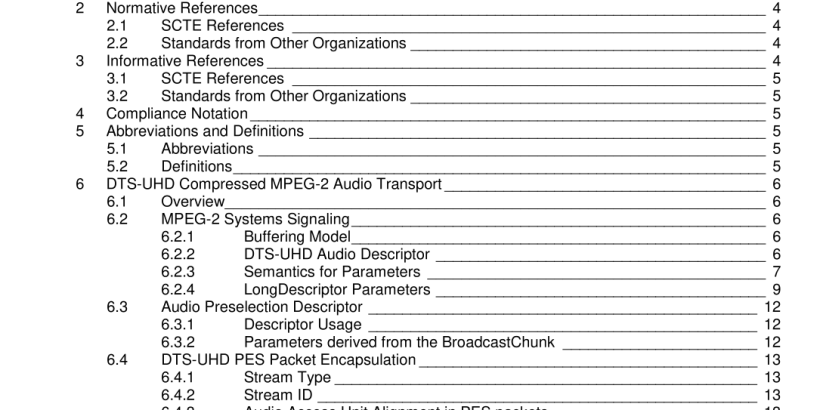ANSI SCTE 243-4-2018 pdf download.Next Generation Audio Carriage for Cable Systems
1.1 Scope
This document is part four of a multi-part standard that specifies carriage constraints of Next Generation Audio (NGA) codecs in MPEG-2 Transport Stream and in MPEG ISO-BMFF media segments. In conjunction with ANSI/SCTE 243-1 [1], this document defines the carriage of DTS-UHD audio in MPEG-2 Transport Stream and MPEG DASH using ISO BMFF media segments.
2 Normative References
The following documents contain provisions, which, through reference in this text, constitute provisions of this document. At the time of Subcommittee approval, the editions indicated were valid. All documents are subject to revision; and while parties to any agreement based on this document are encouraged to investigate the possibility of applying the most recent editions of the documents listed below, they are reminded that newer editions of those documents might not be compatible with the referenced version.
2.1 SCTE References
[1] ANSI/SCTE 243-1 2017, Next Generation Audio Carriage Constraints for Cable Systems: Part 1 – Common Transport Signaling
[2] ANSI/SCTE 242-1 2017, Next Generation Audio Coding Constraints for Cable Systems: Part 1 – Introduction and Common Constraints
[3] SCTE 242-4 2018, Next Generation Audio Coding Constraints for Cable Systems: Part 4 – DTS- UHD Audio Coding Constraints
2.2 Standards from Other Organizations
[4] ISO/IEC 13818-1:2015, Information Technology – Generic coding of moving pictures and associated audio information: Systems
[5] ATSC Standard A/342-1:2017, A/342 Part 1, Audio Common Elements
[6] ISO/IEC 14496-12:2015, Information technology – Coding of audio-visual objects – Part 12: ISO Base Media File Format
[7] ETSI TS 103 491 V1.1.1 (2017-04), DTS-UHD Audio Format; Delivery of Channels, Objects and Ambisonic Sound Fields
[8] ETSI TS 103 584 V1.1.1 (2018-01), DTS-UHD Point Source Renderer
[9] DVB BlueBook A038 (2017-12), Digital Video Broadcasting (DVB); Specification for Service Information (SI) in DVB systems (Final draft of ETSI EN 300 468 v 1.16.1)
[10] IETF RFC 6381 The ‘Codecs’ and ‘Profiles’ Parameters for “Bucket” Media Types
[11] DASH IF: “Guidelines for Implementation: DASH-IF Interoperability Points for ATSC 3.0, Version 1.0,”, January 31, 2016. http://dashif.org/wp-content/uploads/2017/02/DASH-IF-IOP-for-ATSC3-0- v1.0.pdf
4 Compliance Notation
shall This word or the adjective “required” means that the item is an absolute requirement of this document. shall not This phrase means that the item is an absolute prohibition of this document. forbidden This word means the value specified shall never be used. should This word or the adjective “recommended” means that there may exist valid reasons in particular circumstances to ignore this item, but the full implications should be understood and the case carefully weighted before choosing a different course. should not This phrase means that there may exist valid reasons in particular circumstances when the listed behavior is acceptable or even useful, but the full implications should be understood and the case carefully weighed before implementing any behavior described with this label. may This word or the adjective “optional” means that this item is truly optional. One vendor may choose to include the item because a particular marketplace requires it or because it enhances the product, for example; another vendor may omit the same item. deprecated Use is permissible for legacy purposes only. Deprecated features may be removed from future versions of this document. Implementations should avoid use of deprecated features.
5.2 Definitions
This specification uses the definitions defined in ANSI/SCTE 242-1[2] and, by incorporation, ATSC A/342-1[5]. The following terms have definitions specific to DTS-UHD and shall apply to all clauses in this document. Audio Frame – unit of coded audio that, when decoded, will generate defined number of uncompressed Linear PCM audio samples for each wave form Audio Stream – sequence of synchronized Audio Frames. BroadcastChunk – block of data within an audio stream containing data that maps audio components to preselections as defined in SCTE 242-4[3] Frame Duration –time represented by one decoded Audio Frame non-sync frame – Audio Frame that may require prior frames for correct decode (refer to SCTE 242-4 [3]) Object – Audio Element as defined in ATSC A/342-1[2] and referenced in ANSI/SCTE 242-1[1] Object Group – selected collection of audio objects to be played together Presentation – selected collection of Channels, or Objects and Object Groups used together to generate the rendered output ANSI SCTE 243-4-2018 pdf download
